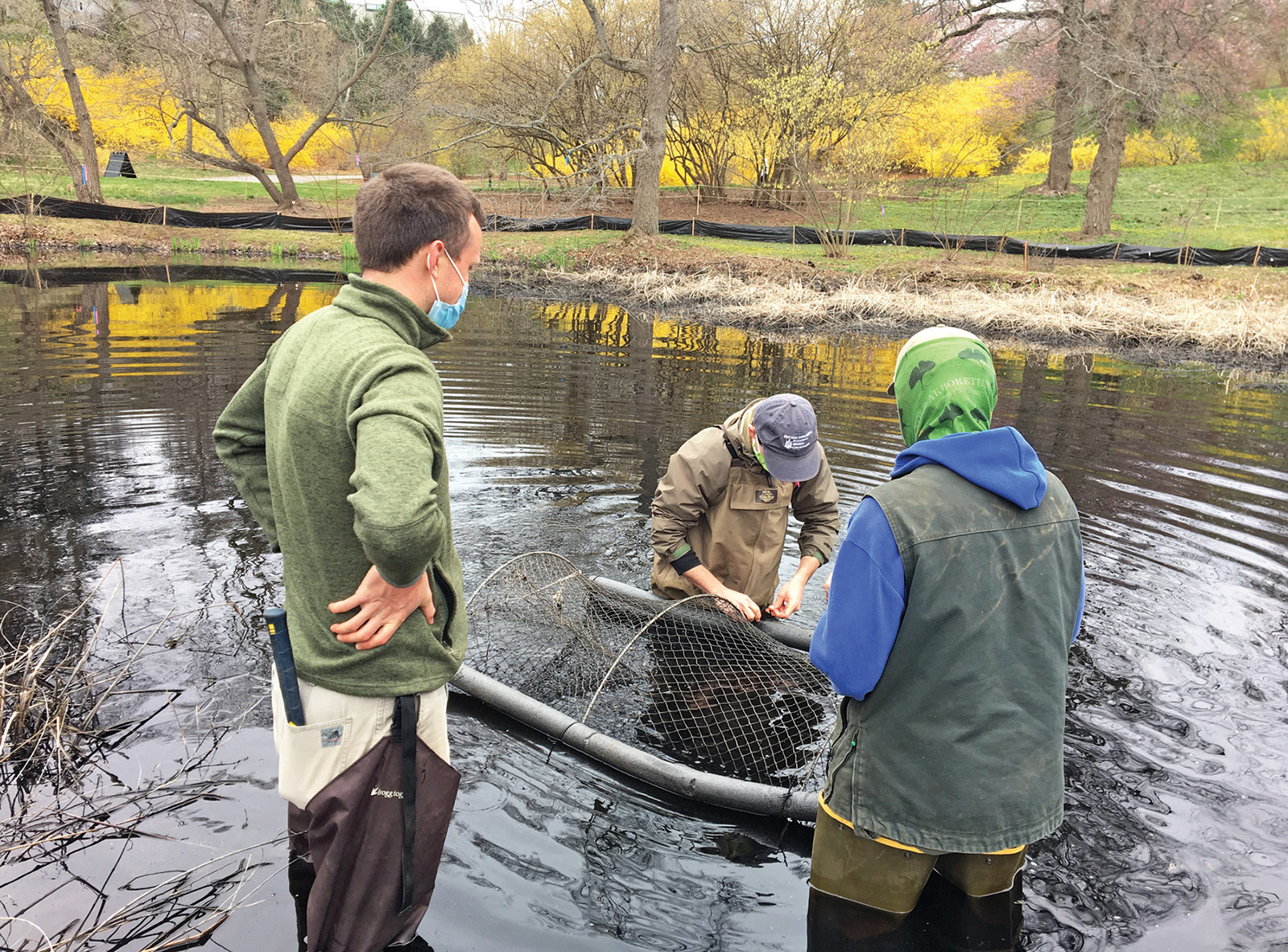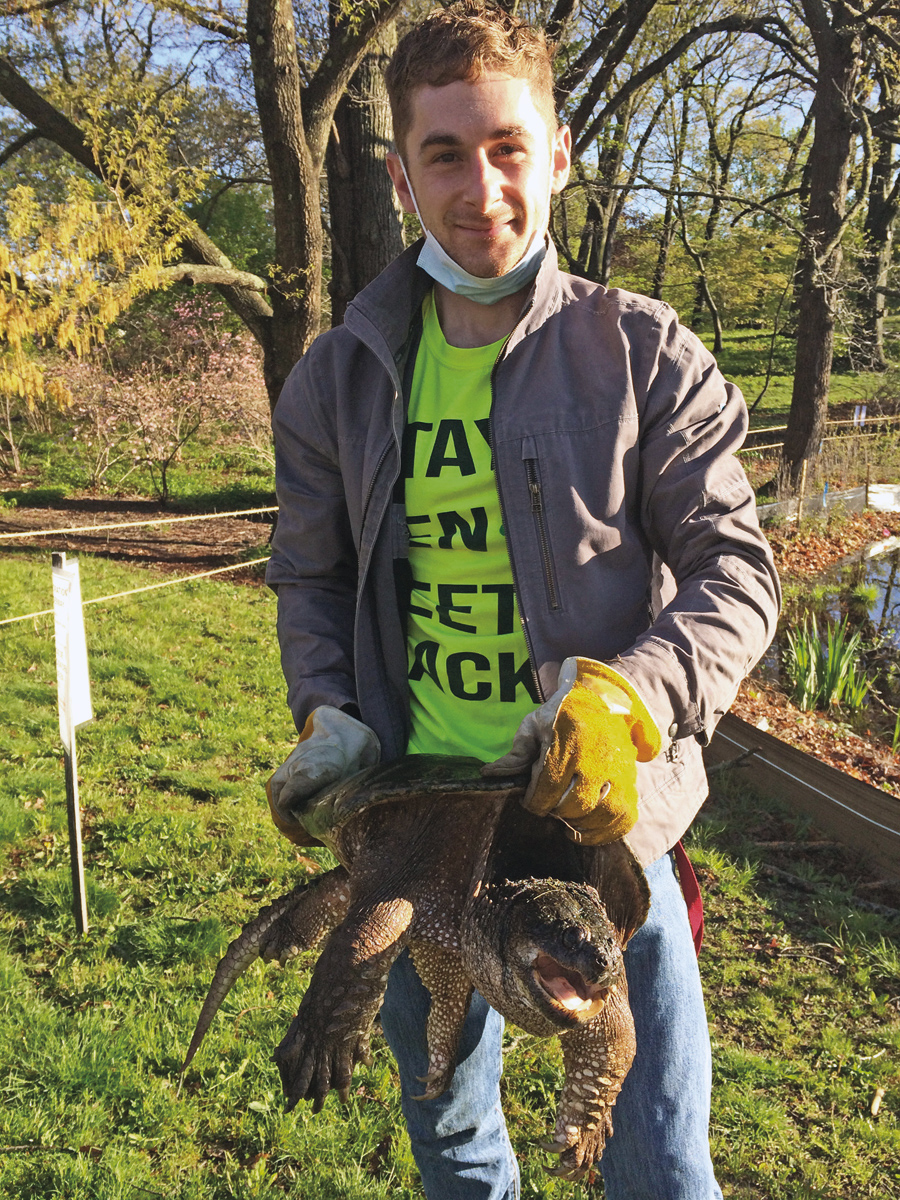Partnering with Zoo New England to preserve turtles and other pond life
Among the most popular visitor destinations at the Arboretum are three man-made ponds—named for Arboretum historical figures Alfred Rehder, Charles Faxon, and Jackson Dawson—which lie adjacent to the Bradley Rosaceous Collection. Last summer, Faxon and Rehder Ponds underwent a massive restoration project. Using a floating barge, contractors removed thousands of square feet of sediment and debris, enlarging the ponds and increasing their capacity and value for storm water management.
Throughout the project, visitors asked about the potential harm caused to aquatic wildlife by the dredging equipment. Of particular concern were turtles, often seen in the water, along the banks, and even crossing the road. Fortunately, a conservation-focused collaboration with Zoo New England ensured that wildlife preservation was part of our planning from the beginning. Working together, we minimized harm to our aquatic organisms while learning more about them and their habitat.
Our wildlife preservation planning for Faxon and Rehder Ponds began last winter when Arboretum staff discussed proposals for our pond restoration project with experts with the zoo’s Field Conservation Department. Department head Dr. Bryan Windmiller and ecologist Dr. Matt Kamm were particularly concerned about our resident turtles because the sediment targeted for removal serves as their hibernation habitat. Furthermore, unlike fish or frogs, turtles have limited capacity to move out of the way once dredging begins. To minimize risk to these animals, Windmiller and Kamm recommended delaying dredging until well after the hibernation period had passed, allowing us to remove as many turtles as possible from the targeted ponds with the time gained.

The first step was easy. We delayed dredging by several weeks, allowing the warm spring weather to coax the turtles from their torpor. The next step—trapping and temporarily relocating the animals—required significant effort. Windmiller and Kamm taught our staff how to install, monitor and remove turtles from floating funnel traps, and tutored us on how to safely carry the turtles to nearby Dawson Pond. They also recommended locations for barrier fencing and bucket traps to prevent relocated turtles from returning to the project sites once dredging got underway. Our staff waded into the ponds each morning to check and rebait the traps, document any turtles caught, and carefully move them to Dawson Pond. Our efforts benefited from baseline surveying work that Zoo New England conducted during summer 2020, in which 38 turtles were caught and given an identifying notch on their shells.
Ultimately, we removed over 80 turtles during six weeks of our daily monitoring activity. These included snapping turtles, painted turtles, and red-eared sliders ranging in size from two-inch hatchlings to a 28-pound snapper approaching 50 years in age. Many of these were the same individuals, caught multiple times as they attempted to return to their home territory or to migrate between ponds. However, at least ten of the turtles had not been previously documented by our colleagues at Zoo New England. This data point may indicate a healthy movement of turtles to and from the wet meadow located nearby.
In addition to turtles, trapped wildlife included American bullfrogs, American toads, and even a brown bullhead catfish. During the Zoo’s 2020 surveying, a yellow-bellied slider, goldfish, koi, and several species of frogs were also tallied. This species composition reflects the cosmopolitan nature of our urban environment. As the ponds are man-made, the organisms within them must have either migrated from nearby wetlands or been introduced. The snapping and painted turtles may well have come from the historic wet meadow, itself a former Atlantic white cedar bog. However, the goldfish, koi, and pond sliders likely originated from fish tanks elsewhere. After outgrowing their tanks (or their welcome), these animals were “freed” to our ponds, an unfortunately common urban practice that has long-term, detrimental impacts on local wildlife. Red-eared sliders, for example, grow much larger than our native painted turtles and out-compete them for feeding and basking territories.

Once dredging concluded, we removed the fencing, buckets, and traps and watched as the turtles resumed their migrations into our renovated ponds. Turtles have keen memories for location and the disturbance will not have gone unnoticed. To help patch up their habitat, we replanted damaged sections of shoreline with locally-sourced native plants. In addition, dead trees and branches were laid along the shoreline to serve as cover and basking locations while the vegetation re-establishes.
The project also offered an opportunity for us to help turtle conservation efforts championed by Zoo New England elsewhere in the state. Prior to dredging, Zoo and Arboretum staff took cuttings of swamp loosestrife (Decodon verticillatus) growing in Faxon and Rehder ponds. The Zoo used these cuttings for improving wetlands they manage for Blanding’s turtles, a threatened species in Massachusetts. Swamp loosestrife provides valuable shelter for young Blanding’s turtle hatchlings as they forage for food and hide from predators in the shrubby wetlands which this species prefers.
After a summer of heavy rain, the swelled banks of Rehder and Faxon Ponds exhibited their value for stormwater management. Meanwhile, ongoing survey work will help determine how turtles and other wildlife adapt to the new conditions. As with the thousands of plants we grow and steward, we remain ever eager and committed to protect and learn more about them.

